Volkswagen AG: Brand Management and Strategic Analysis Report
VerifiedAdded on 2020/06/05
|21
|5585
|61
Report
AI Summary
This report provides a comprehensive analysis of Volkswagen AG's brand management strategies. It begins with an introduction to branding and its significance as a marketing tool, emphasizing the importance of brand image and customer loyalty in the automotive industry. The report then delves into Volkswagen's branding strategies, including its slogan and approach to electric vehicles. It examines the key components of a successful brand strategy, such as digital marketing, public relations, and social media, and discusses the management of brand equity. The report also outlines the challenges Volkswagen faces in emerging markets and concludes with an overview of the methods and tools used to evaluate and manage brand value, highlighting the importance of brand loyalty, awareness, and perceived quality. Overall, the report provides valuable insights into Volkswagen's brand management practices and their impact on the company's market position.

Brand management
Paraphrase This Document
Need a fresh take? Get an instant paraphrase of this document with our AI Paraphraser
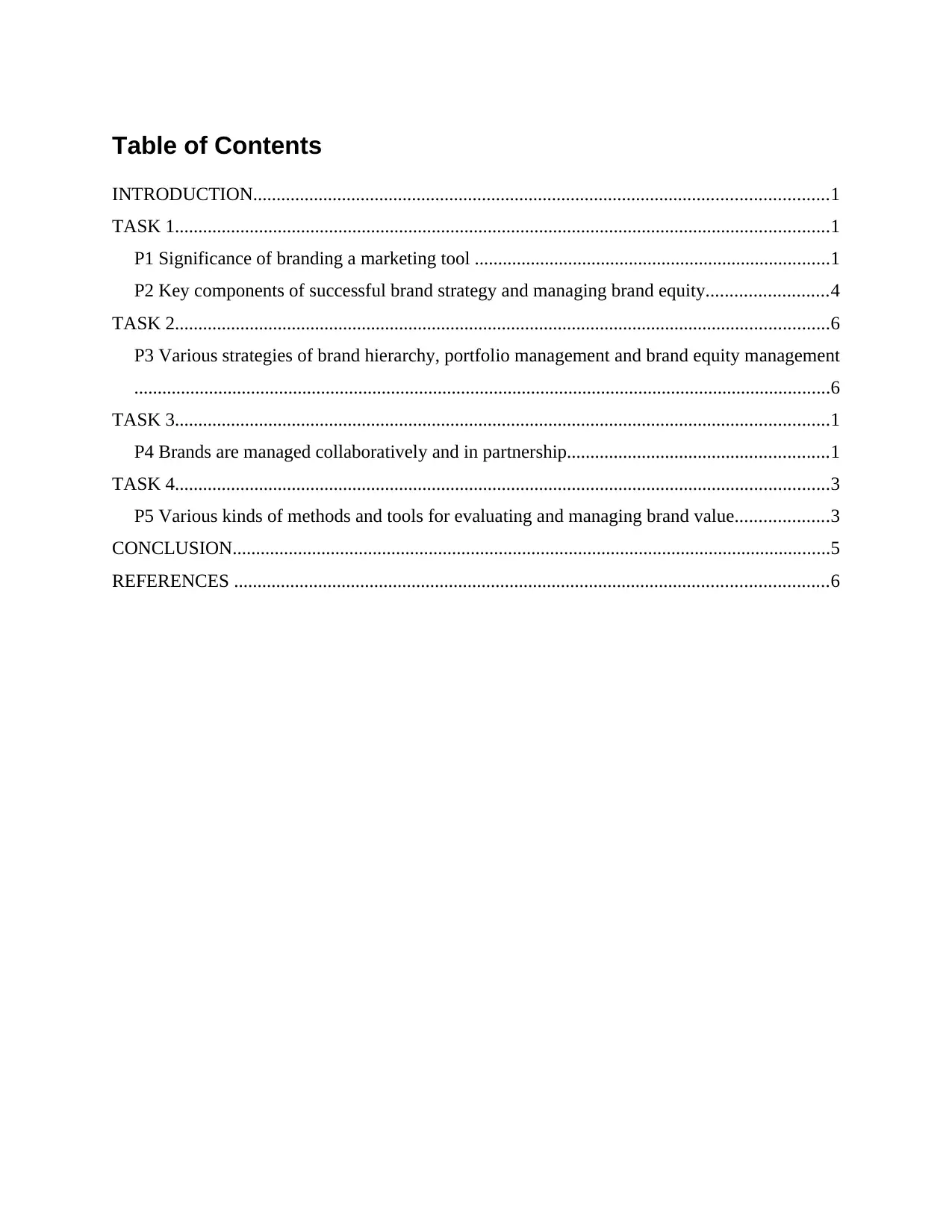
Table of Contents
INTRODUCTION...........................................................................................................................1
TASK 1............................................................................................................................................1
P1 Significance of branding a marketing tool ............................................................................1
P2 Key components of successful brand strategy and managing brand equity..........................4
TASK 2............................................................................................................................................6
P3 Various strategies of brand hierarchy, portfolio management and brand equity management
.....................................................................................................................................................6
TASK 3............................................................................................................................................1
P4 Brands are managed collaboratively and in partnership........................................................1
TASK 4............................................................................................................................................3
P5 Various kinds of methods and tools for evaluating and managing brand value....................3
CONCLUSION................................................................................................................................5
REFERENCES ...............................................................................................................................6
INTRODUCTION...........................................................................................................................1
TASK 1............................................................................................................................................1
P1 Significance of branding a marketing tool ............................................................................1
P2 Key components of successful brand strategy and managing brand equity..........................4
TASK 2............................................................................................................................................6
P3 Various strategies of brand hierarchy, portfolio management and brand equity management
.....................................................................................................................................................6
TASK 3............................................................................................................................................1
P4 Brands are managed collaboratively and in partnership........................................................1
TASK 4............................................................................................................................................3
P5 Various kinds of methods and tools for evaluating and managing brand value....................3
CONCLUSION................................................................................................................................5
REFERENCES ...............................................................................................................................6
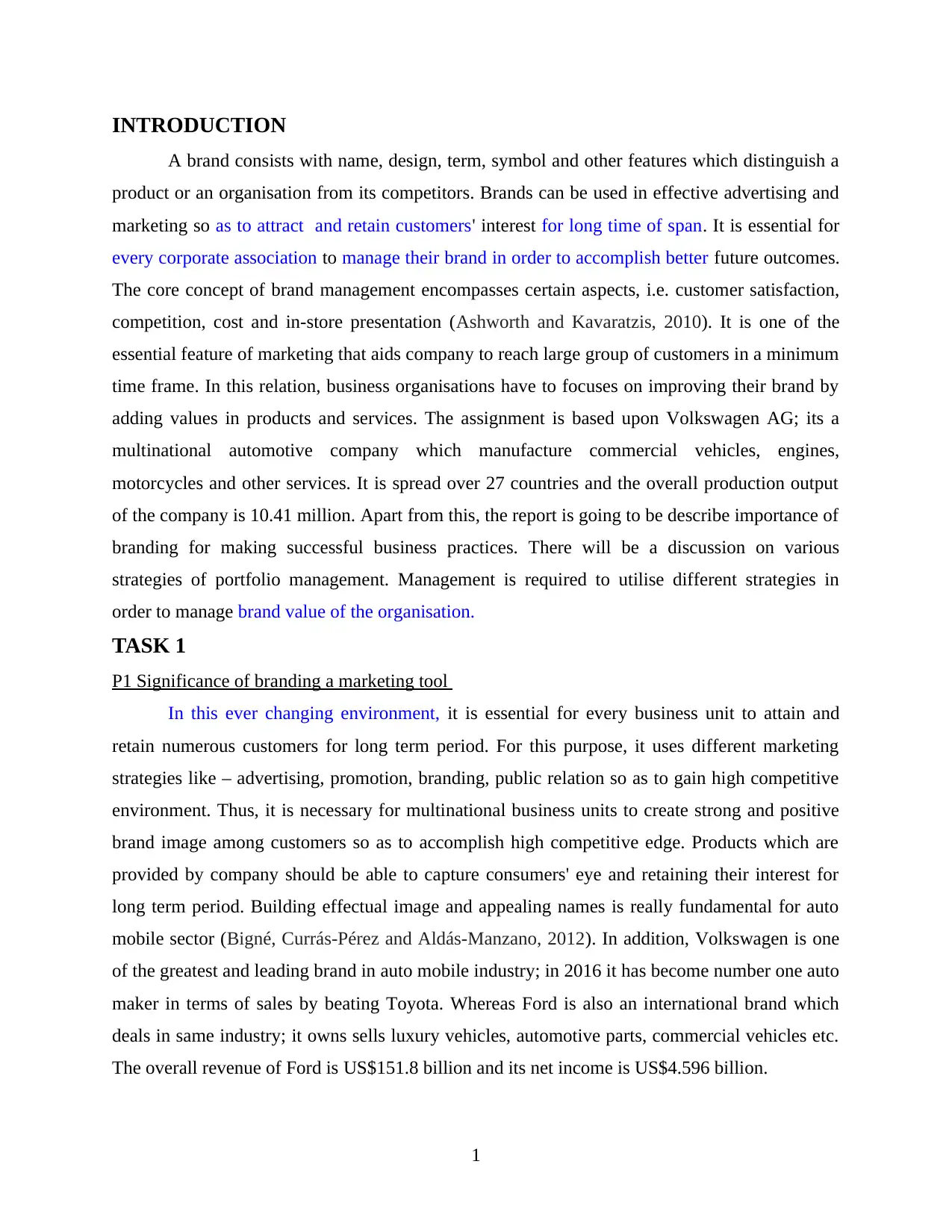
INTRODUCTION
A brand consists with name, design, term, symbol and other features which distinguish a
product or an organisation from its competitors. Brands can be used in effective advertising and
marketing so as to attract and retain customers' interest for long time of span. It is essential for
every corporate association to manage their brand in order to accomplish better future outcomes.
The core concept of brand management encompasses certain aspects, i.e. customer satisfaction,
competition, cost and in-store presentation (Ashworth and Kavaratzis, 2010). It is one of the
essential feature of marketing that aids company to reach large group of customers in a minimum
time frame. In this relation, business organisations have to focuses on improving their brand by
adding values in products and services. The assignment is based upon Volkswagen AG; its a
multinational automotive company which manufacture commercial vehicles, engines,
motorcycles and other services. It is spread over 27 countries and the overall production output
of the company is 10.41 million. Apart from this, the report is going to be describe importance of
branding for making successful business practices. There will be a discussion on various
strategies of portfolio management. Management is required to utilise different strategies in
order to manage brand value of the organisation.
TASK 1
P1 Significance of branding a marketing tool
In this ever changing environment, it is essential for every business unit to attain and
retain numerous customers for long term period. For this purpose, it uses different marketing
strategies like – advertising, promotion, branding, public relation so as to gain high competitive
environment. Thus, it is necessary for multinational business units to create strong and positive
brand image among customers so as to accomplish high competitive edge. Products which are
provided by company should be able to capture consumers' eye and retaining their interest for
long term period. Building effectual image and appealing names is really fundamental for auto
mobile sector (Bigné, Currás-Pérez and Aldás-Manzano, 2012). In addition, Volkswagen is one
of the greatest and leading brand in auto mobile industry; in 2016 it has become number one auto
maker in terms of sales by beating Toyota. Whereas Ford is also an international brand which
deals in same industry; it owns sells luxury vehicles, automotive parts, commercial vehicles etc.
The overall revenue of Ford is US$151.8 billion and its net income is US$4.596 billion.
1
A brand consists with name, design, term, symbol and other features which distinguish a
product or an organisation from its competitors. Brands can be used in effective advertising and
marketing so as to attract and retain customers' interest for long time of span. It is essential for
every corporate association to manage their brand in order to accomplish better future outcomes.
The core concept of brand management encompasses certain aspects, i.e. customer satisfaction,
competition, cost and in-store presentation (Ashworth and Kavaratzis, 2010). It is one of the
essential feature of marketing that aids company to reach large group of customers in a minimum
time frame. In this relation, business organisations have to focuses on improving their brand by
adding values in products and services. The assignment is based upon Volkswagen AG; its a
multinational automotive company which manufacture commercial vehicles, engines,
motorcycles and other services. It is spread over 27 countries and the overall production output
of the company is 10.41 million. Apart from this, the report is going to be describe importance of
branding for making successful business practices. There will be a discussion on various
strategies of portfolio management. Management is required to utilise different strategies in
order to manage brand value of the organisation.
TASK 1
P1 Significance of branding a marketing tool
In this ever changing environment, it is essential for every business unit to attain and
retain numerous customers for long term period. For this purpose, it uses different marketing
strategies like – advertising, promotion, branding, public relation so as to gain high competitive
environment. Thus, it is necessary for multinational business units to create strong and positive
brand image among customers so as to accomplish high competitive edge. Products which are
provided by company should be able to capture consumers' eye and retaining their interest for
long term period. Building effectual image and appealing names is really fundamental for auto
mobile sector (Bigné, Currás-Pérez and Aldás-Manzano, 2012). In addition, Volkswagen is one
of the greatest and leading brand in auto mobile industry; in 2016 it has become number one auto
maker in terms of sales by beating Toyota. Whereas Ford is also an international brand which
deals in same industry; it owns sells luxury vehicles, automotive parts, commercial vehicles etc.
The overall revenue of Ford is US$151.8 billion and its net income is US$4.596 billion.
1
⊘ This is a preview!⊘
Do you want full access?
Subscribe today to unlock all pages.

Trusted by 1+ million students worldwide
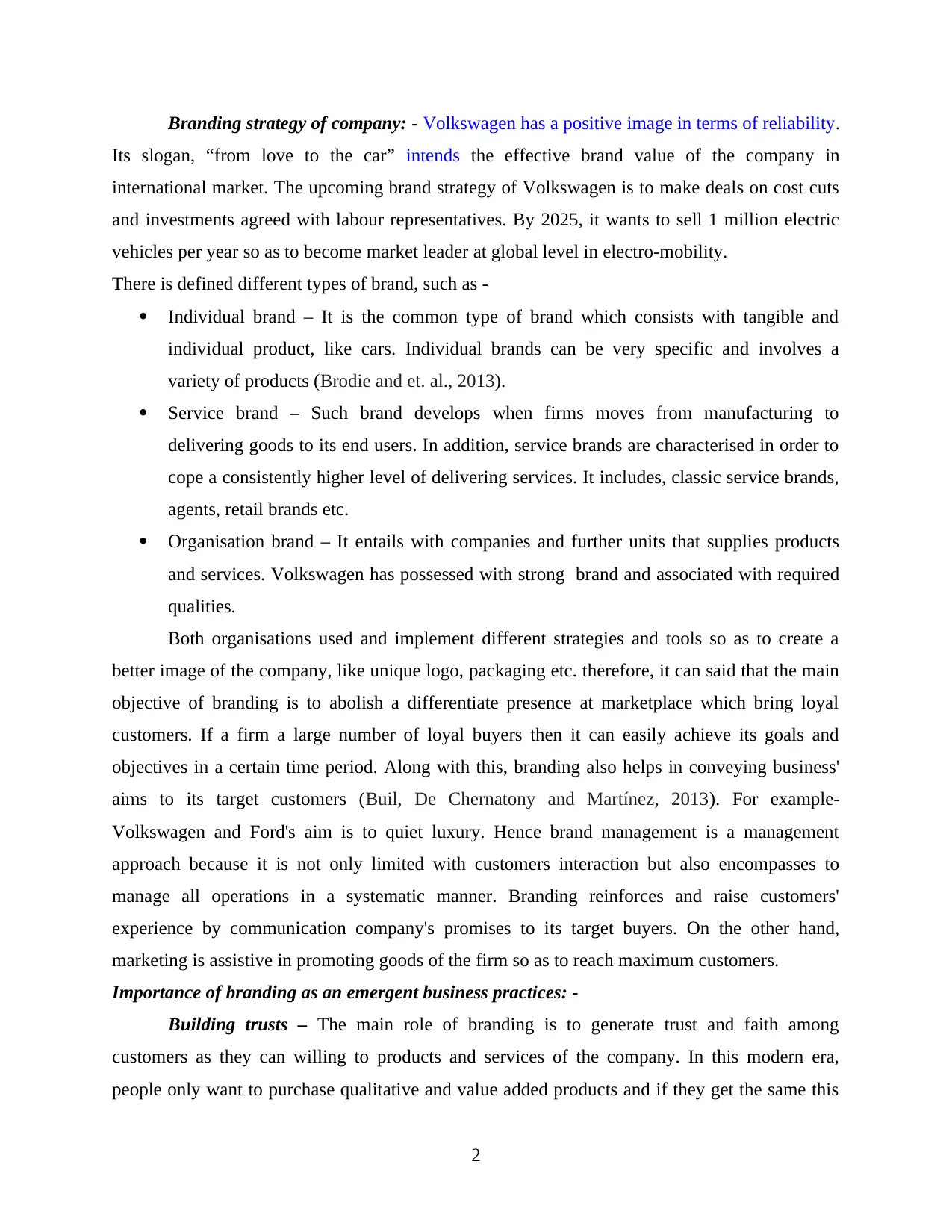
Branding strategy of company: - Volkswagen has a positive image in terms of reliability.
Its slogan, “from love to the car” intends the effective brand value of the company in
international market. The upcoming brand strategy of Volkswagen is to make deals on cost cuts
and investments agreed with labour representatives. By 2025, it wants to sell 1 million electric
vehicles per year so as to become market leader at global level in electro-mobility.
There is defined different types of brand, such as -
Individual brand – It is the common type of brand which consists with tangible and
individual product, like cars. Individual brands can be very specific and involves a
variety of products (Brodie and et. al., 2013).
Service brand – Such brand develops when firms moves from manufacturing to
delivering goods to its end users. In addition, service brands are characterised in order to
cope a consistently higher level of delivering services. It includes, classic service brands,
agents, retail brands etc.
Organisation brand – It entails with companies and further units that supplies products
and services. Volkswagen has possessed with strong brand and associated with required
qualities.
Both organisations used and implement different strategies and tools so as to create a
better image of the company, like unique logo, packaging etc. therefore, it can said that the main
objective of branding is to abolish a differentiate presence at marketplace which bring loyal
customers. If a firm a large number of loyal buyers then it can easily achieve its goals and
objectives in a certain time period. Along with this, branding also helps in conveying business'
aims to its target customers (Buil, De Chernatony and Martínez, 2013). For example-
Volkswagen and Ford's aim is to quiet luxury. Hence brand management is a management
approach because it is not only limited with customers interaction but also encompasses to
manage all operations in a systematic manner. Branding reinforces and raise customers'
experience by communication company's promises to its target buyers. On the other hand,
marketing is assistive in promoting goods of the firm so as to reach maximum customers.
Importance of branding as an emergent business practices: -
Building trusts – The main role of branding is to generate trust and faith among
customers as they can willing to products and services of the company. In this modern era,
people only want to purchase qualitative and value added products and if they get the same this
2
Its slogan, “from love to the car” intends the effective brand value of the company in
international market. The upcoming brand strategy of Volkswagen is to make deals on cost cuts
and investments agreed with labour representatives. By 2025, it wants to sell 1 million electric
vehicles per year so as to become market leader at global level in electro-mobility.
There is defined different types of brand, such as -
Individual brand – It is the common type of brand which consists with tangible and
individual product, like cars. Individual brands can be very specific and involves a
variety of products (Brodie and et. al., 2013).
Service brand – Such brand develops when firms moves from manufacturing to
delivering goods to its end users. In addition, service brands are characterised in order to
cope a consistently higher level of delivering services. It includes, classic service brands,
agents, retail brands etc.
Organisation brand – It entails with companies and further units that supplies products
and services. Volkswagen has possessed with strong brand and associated with required
qualities.
Both organisations used and implement different strategies and tools so as to create a
better image of the company, like unique logo, packaging etc. therefore, it can said that the main
objective of branding is to abolish a differentiate presence at marketplace which bring loyal
customers. If a firm a large number of loyal buyers then it can easily achieve its goals and
objectives in a certain time period. Along with this, branding also helps in conveying business'
aims to its target customers (Buil, De Chernatony and Martínez, 2013). For example-
Volkswagen and Ford's aim is to quiet luxury. Hence brand management is a management
approach because it is not only limited with customers interaction but also encompasses to
manage all operations in a systematic manner. Branding reinforces and raise customers'
experience by communication company's promises to its target buyers. On the other hand,
marketing is assistive in promoting goods of the firm so as to reach maximum customers.
Importance of branding as an emergent business practices: -
Building trusts – The main role of branding is to generate trust and faith among
customers as they can willing to products and services of the company. In this modern era,
people only want to purchase qualitative and value added products and if they get the same this
2
Paraphrase This Document
Need a fresh take? Get an instant paraphrase of this document with our AI Paraphraser
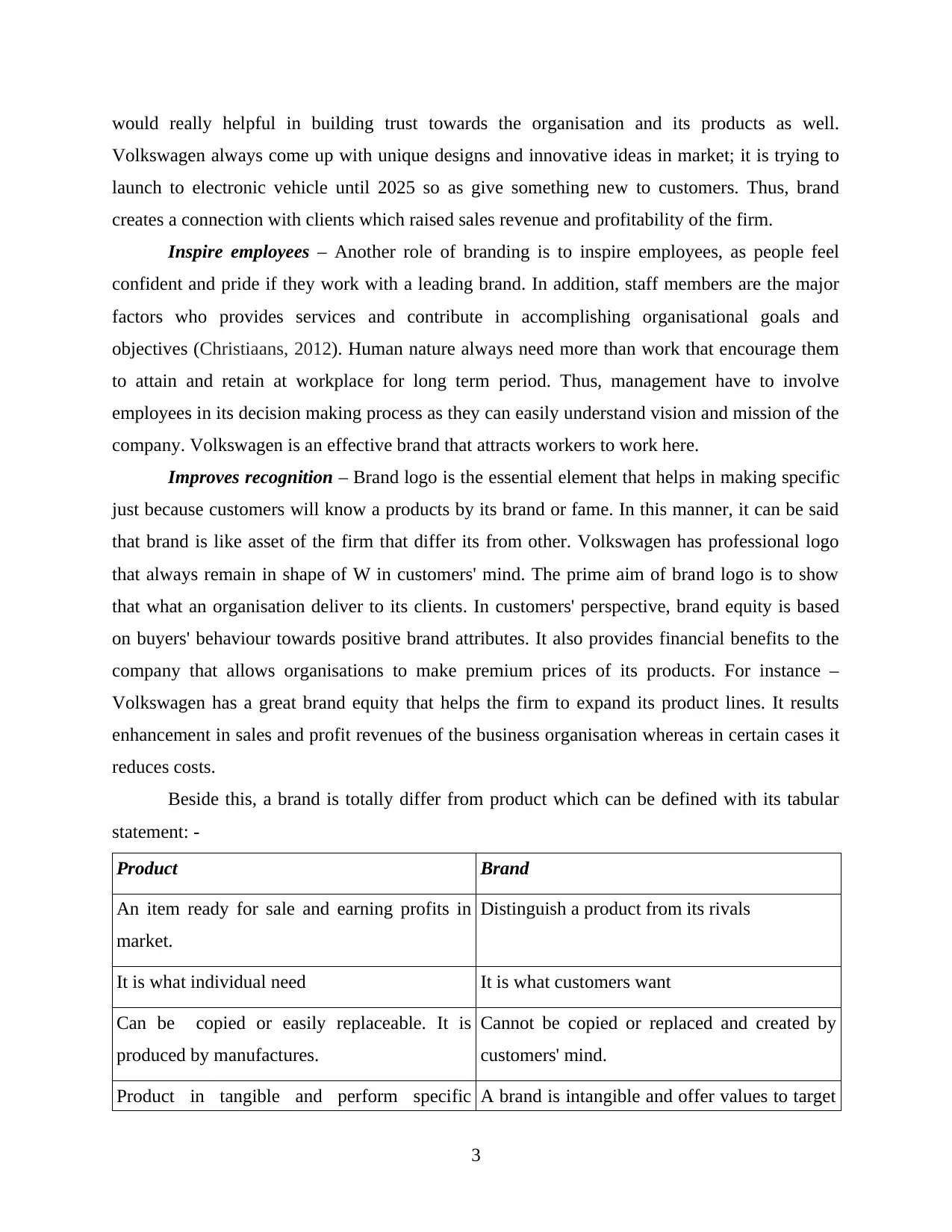
would really helpful in building trust towards the organisation and its products as well.
Volkswagen always come up with unique designs and innovative ideas in market; it is trying to
launch to electronic vehicle until 2025 so as give something new to customers. Thus, brand
creates a connection with clients which raised sales revenue and profitability of the firm.
Inspire employees – Another role of branding is to inspire employees, as people feel
confident and pride if they work with a leading brand. In addition, staff members are the major
factors who provides services and contribute in accomplishing organisational goals and
objectives (Christiaans, 2012). Human nature always need more than work that encourage them
to attain and retain at workplace for long term period. Thus, management have to involve
employees in its decision making process as they can easily understand vision and mission of the
company. Volkswagen is an effective brand that attracts workers to work here.
Improves recognition – Brand logo is the essential element that helps in making specific
just because customers will know a products by its brand or fame. In this manner, it can be said
that brand is like asset of the firm that differ its from other. Volkswagen has professional logo
that always remain in shape of W in customers' mind. The prime aim of brand logo is to show
that what an organisation deliver to its clients. In customers' perspective, brand equity is based
on buyers' behaviour towards positive brand attributes. It also provides financial benefits to the
company that allows organisations to make premium prices of its products. For instance –
Volkswagen has a great brand equity that helps the firm to expand its product lines. It results
enhancement in sales and profit revenues of the business organisation whereas in certain cases it
reduces costs.
Beside this, a brand is totally differ from product which can be defined with its tabular
statement: -
Product Brand
An item ready for sale and earning profits in
market.
Distinguish a product from its rivals
It is what individual need It is what customers want
Can be copied or easily replaceable. It is
produced by manufactures.
Cannot be copied or replaced and created by
customers' mind.
Product in tangible and perform specific A brand is intangible and offer values to target
3
Volkswagen always come up with unique designs and innovative ideas in market; it is trying to
launch to electronic vehicle until 2025 so as give something new to customers. Thus, brand
creates a connection with clients which raised sales revenue and profitability of the firm.
Inspire employees – Another role of branding is to inspire employees, as people feel
confident and pride if they work with a leading brand. In addition, staff members are the major
factors who provides services and contribute in accomplishing organisational goals and
objectives (Christiaans, 2012). Human nature always need more than work that encourage them
to attain and retain at workplace for long term period. Thus, management have to involve
employees in its decision making process as they can easily understand vision and mission of the
company. Volkswagen is an effective brand that attracts workers to work here.
Improves recognition – Brand logo is the essential element that helps in making specific
just because customers will know a products by its brand or fame. In this manner, it can be said
that brand is like asset of the firm that differ its from other. Volkswagen has professional logo
that always remain in shape of W in customers' mind. The prime aim of brand logo is to show
that what an organisation deliver to its clients. In customers' perspective, brand equity is based
on buyers' behaviour towards positive brand attributes. It also provides financial benefits to the
company that allows organisations to make premium prices of its products. For instance –
Volkswagen has a great brand equity that helps the firm to expand its product lines. It results
enhancement in sales and profit revenues of the business organisation whereas in certain cases it
reduces costs.
Beside this, a brand is totally differ from product which can be defined with its tabular
statement: -
Product Brand
An item ready for sale and earning profits in
market.
Distinguish a product from its rivals
It is what individual need It is what customers want
Can be copied or easily replaceable. It is
produced by manufactures.
Cannot be copied or replaced and created by
customers' mind.
Product in tangible and perform specific A brand is intangible and offer values to target
3
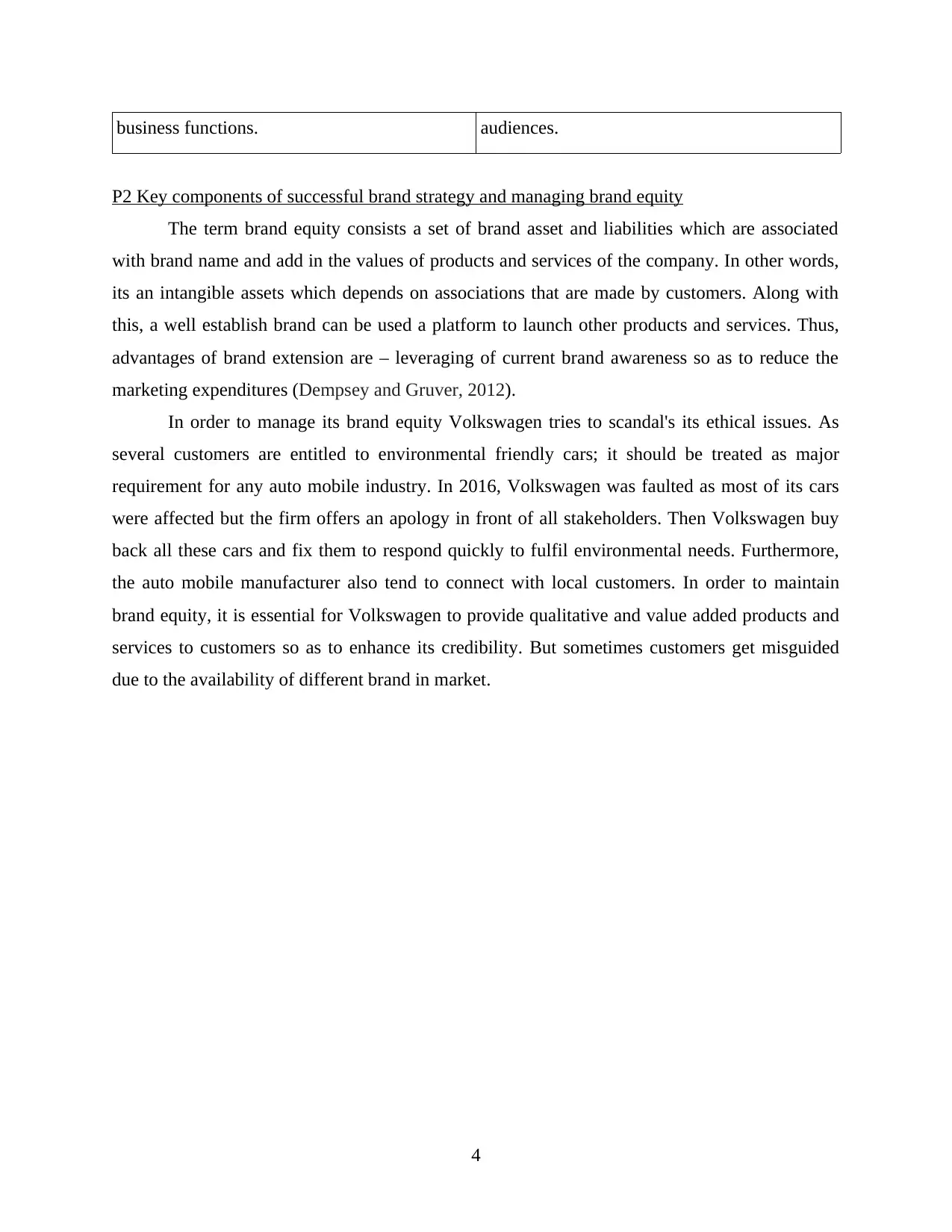
business functions. audiences.
P2 Key components of successful brand strategy and managing brand equity
The term brand equity consists a set of brand asset and liabilities which are associated
with brand name and add in the values of products and services of the company. In other words,
its an intangible assets which depends on associations that are made by customers. Along with
this, a well establish brand can be used a platform to launch other products and services. Thus,
advantages of brand extension are – leveraging of current brand awareness so as to reduce the
marketing expenditures (Dempsey and Gruver, 2012).
In order to manage its brand equity Volkswagen tries to scandal's its ethical issues. As
several customers are entitled to environmental friendly cars; it should be treated as major
requirement for any auto mobile industry. In 2016, Volkswagen was faulted as most of its cars
were affected but the firm offers an apology in front of all stakeholders. Then Volkswagen buy
back all these cars and fix them to respond quickly to fulfil environmental needs. Furthermore,
the auto mobile manufacturer also tend to connect with local customers. In order to maintain
brand equity, it is essential for Volkswagen to provide qualitative and value added products and
services to customers so as to enhance its credibility. But sometimes customers get misguided
due to the availability of different brand in market.
4
P2 Key components of successful brand strategy and managing brand equity
The term brand equity consists a set of brand asset and liabilities which are associated
with brand name and add in the values of products and services of the company. In other words,
its an intangible assets which depends on associations that are made by customers. Along with
this, a well establish brand can be used a platform to launch other products and services. Thus,
advantages of brand extension are – leveraging of current brand awareness so as to reduce the
marketing expenditures (Dempsey and Gruver, 2012).
In order to manage its brand equity Volkswagen tries to scandal's its ethical issues. As
several customers are entitled to environmental friendly cars; it should be treated as major
requirement for any auto mobile industry. In 2016, Volkswagen was faulted as most of its cars
were affected but the firm offers an apology in front of all stakeholders. Then Volkswagen buy
back all these cars and fix them to respond quickly to fulfil environmental needs. Furthermore,
the auto mobile manufacturer also tend to connect with local customers. In order to maintain
brand equity, it is essential for Volkswagen to provide qualitative and value added products and
services to customers so as to enhance its credibility. But sometimes customers get misguided
due to the availability of different brand in market.
4
⊘ This is a preview!⊘
Do you want full access?
Subscribe today to unlock all pages.

Trusted by 1+ million students worldwide
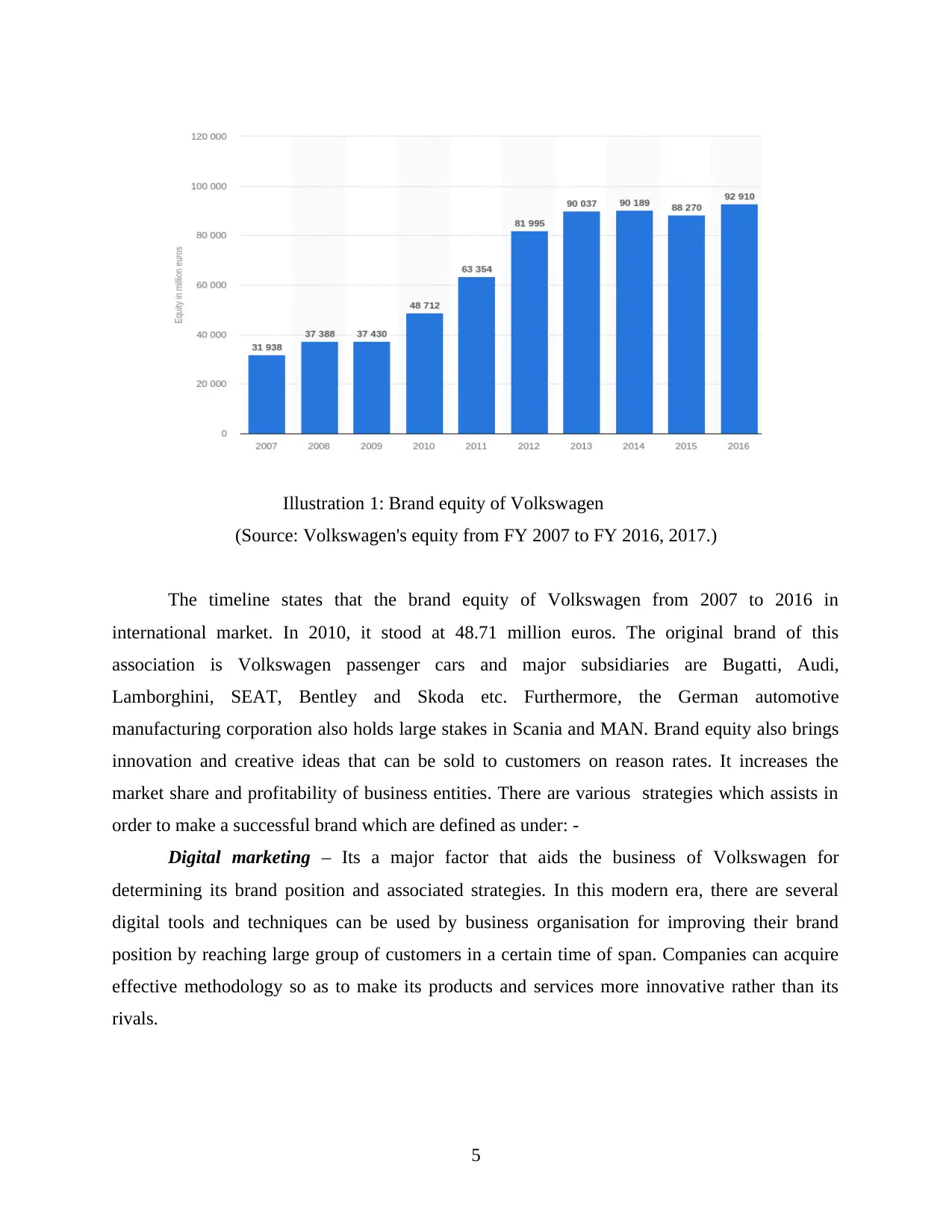
(Source: Volkswagen's equity from FY 2007 to FY 2016, 2017.)
The timeline states that the brand equity of Volkswagen from 2007 to 2016 in
international market. In 2010, it stood at 48.71 million euros. The original brand of this
association is Volkswagen passenger cars and major subsidiaries are Bugatti, Audi,
Lamborghini, SEAT, Bentley and Skoda etc. Furthermore, the German automotive
manufacturing corporation also holds large stakes in Scania and MAN. Brand equity also brings
innovation and creative ideas that can be sold to customers on reason rates. It increases the
market share and profitability of business entities. There are various strategies which assists in
order to make a successful brand which are defined as under: -
Digital marketing – Its a major factor that aids the business of Volkswagen for
determining its brand position and associated strategies. In this modern era, there are several
digital tools and techniques can be used by business organisation for improving their brand
position by reaching large group of customers in a certain time of span. Companies can acquire
effective methodology so as to make its products and services more innovative rather than its
rivals.
5
Illustration 1: Brand equity of Volkswagen
The timeline states that the brand equity of Volkswagen from 2007 to 2016 in
international market. In 2010, it stood at 48.71 million euros. The original brand of this
association is Volkswagen passenger cars and major subsidiaries are Bugatti, Audi,
Lamborghini, SEAT, Bentley and Skoda etc. Furthermore, the German automotive
manufacturing corporation also holds large stakes in Scania and MAN. Brand equity also brings
innovation and creative ideas that can be sold to customers on reason rates. It increases the
market share and profitability of business entities. There are various strategies which assists in
order to make a successful brand which are defined as under: -
Digital marketing – Its a major factor that aids the business of Volkswagen for
determining its brand position and associated strategies. In this modern era, there are several
digital tools and techniques can be used by business organisation for improving their brand
position by reaching large group of customers in a certain time of span. Companies can acquire
effective methodology so as to make its products and services more innovative rather than its
rivals.
5
Illustration 1: Brand equity of Volkswagen
Paraphrase This Document
Need a fresh take? Get an instant paraphrase of this document with our AI Paraphraser
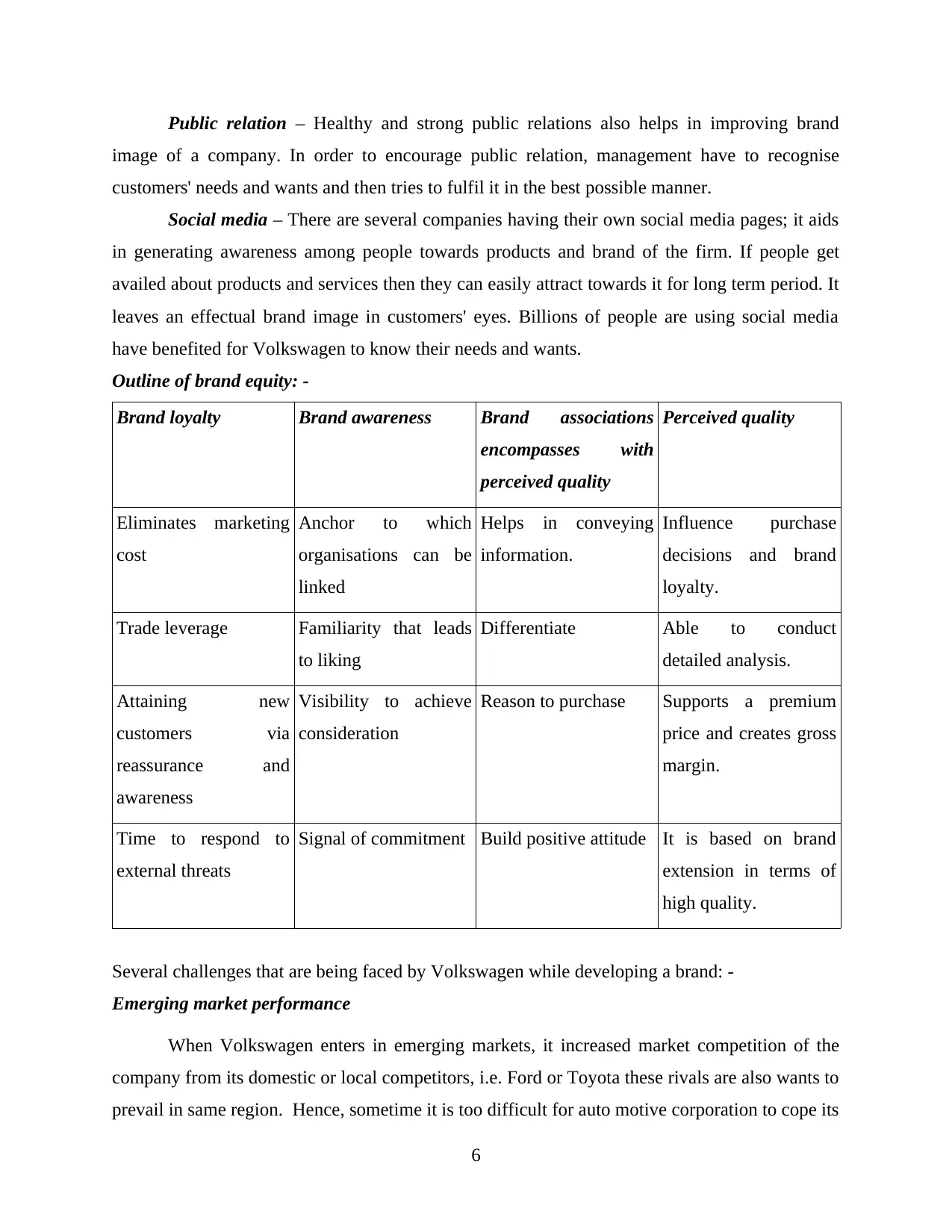
Public relation – Healthy and strong public relations also helps in improving brand
image of a company. In order to encourage public relation, management have to recognise
customers' needs and wants and then tries to fulfil it in the best possible manner.
Social media – There are several companies having their own social media pages; it aids
in generating awareness among people towards products and brand of the firm. If people get
availed about products and services then they can easily attract towards it for long term period. It
leaves an effectual brand image in customers' eyes. Billions of people are using social media
have benefited for Volkswagen to know their needs and wants.
Outline of brand equity: -
Brand loyalty Brand awareness Brand associations
encompasses with
perceived quality
Perceived quality
Eliminates marketing
cost
Anchor to which
organisations can be
linked
Helps in conveying
information.
Influence purchase
decisions and brand
loyalty.
Trade leverage Familiarity that leads
to liking
Differentiate Able to conduct
detailed analysis.
Attaining new
customers via
reassurance and
awareness
Visibility to achieve
consideration
Reason to purchase Supports a premium
price and creates gross
margin.
Time to respond to
external threats
Signal of commitment Build positive attitude It is based on brand
extension in terms of
high quality.
Several challenges that are being faced by Volkswagen while developing a brand: -
Emerging market performance
When Volkswagen enters in emerging markets, it increased market competition of the
company from its domestic or local competitors, i.e. Ford or Toyota these rivals are also wants to
prevail in same region. Hence, sometime it is too difficult for auto motive corporation to cope its
6
image of a company. In order to encourage public relation, management have to recognise
customers' needs and wants and then tries to fulfil it in the best possible manner.
Social media – There are several companies having their own social media pages; it aids
in generating awareness among people towards products and brand of the firm. If people get
availed about products and services then they can easily attract towards it for long term period. It
leaves an effectual brand image in customers' eyes. Billions of people are using social media
have benefited for Volkswagen to know their needs and wants.
Outline of brand equity: -
Brand loyalty Brand awareness Brand associations
encompasses with
perceived quality
Perceived quality
Eliminates marketing
cost
Anchor to which
organisations can be
linked
Helps in conveying
information.
Influence purchase
decisions and brand
loyalty.
Trade leverage Familiarity that leads
to liking
Differentiate Able to conduct
detailed analysis.
Attaining new
customers via
reassurance and
awareness
Visibility to achieve
consideration
Reason to purchase Supports a premium
price and creates gross
margin.
Time to respond to
external threats
Signal of commitment Build positive attitude It is based on brand
extension in terms of
high quality.
Several challenges that are being faced by Volkswagen while developing a brand: -
Emerging market performance
When Volkswagen enters in emerging markets, it increased market competition of the
company from its domestic or local competitors, i.e. Ford or Toyota these rivals are also wants to
prevail in same region. Hence, sometime it is too difficult for auto motive corporation to cope its
6
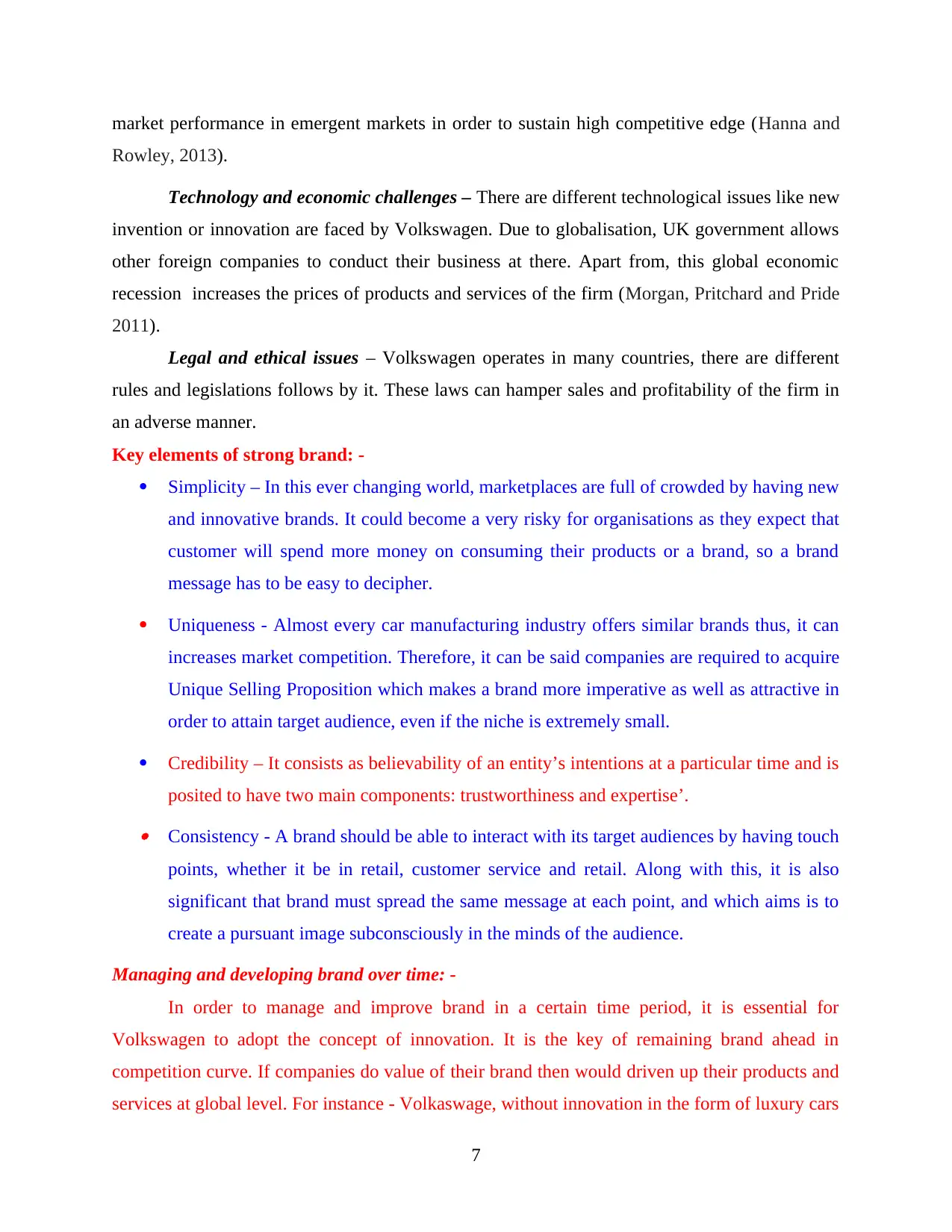
market performance in emergent markets in order to sustain high competitive edge (Hanna and
Rowley, 2013).
Technology and economic challenges – There are different technological issues like new
invention or innovation are faced by Volkswagen. Due to globalisation, UK government allows
other foreign companies to conduct their business at there. Apart from, this global economic
recession increases the prices of products and services of the firm (Morgan, Pritchard and Pride
2011).
Legal and ethical issues – Volkswagen operates in many countries, there are different
rules and legislations follows by it. These laws can hamper sales and profitability of the firm in
an adverse manner.
Key elements of strong brand: -
Simplicity – In this ever changing world, marketplaces are full of crowded by having new
and innovative brands. It could become a very risky for organisations as they expect that
customer will spend more money on consuming their products or a brand, so a brand
message has to be easy to decipher.
Uniqueness - Almost every car manufacturing industry offers similar brands thus, it can
increases market competition. Therefore, it can be said companies are required to acquire
Unique Selling Proposition which makes a brand more imperative as well as attractive in
order to attain target audience, even if the niche is extremely small.
Credibility – It consists as believability of an entity’s intentions at a particular time and is
posited to have two main components: trustworthiness and expertise’. Consistency - A brand should be able to interact with its target audiences by having touch
points, whether it be in retail, customer service and retail. Along with this, it is also
significant that brand must spread the same message at each point, and which aims is to
create a pursuant image subconsciously in the minds of the audience.
Managing and developing brand over time: -
In order to manage and improve brand in a certain time period, it is essential for
Volkswagen to adopt the concept of innovation. It is the key of remaining brand ahead in
competition curve. If companies do value of their brand then would driven up their products and
services at global level. For instance - Volkaswage, without innovation in the form of luxury cars
7
Rowley, 2013).
Technology and economic challenges – There are different technological issues like new
invention or innovation are faced by Volkswagen. Due to globalisation, UK government allows
other foreign companies to conduct their business at there. Apart from, this global economic
recession increases the prices of products and services of the firm (Morgan, Pritchard and Pride
2011).
Legal and ethical issues – Volkswagen operates in many countries, there are different
rules and legislations follows by it. These laws can hamper sales and profitability of the firm in
an adverse manner.
Key elements of strong brand: -
Simplicity – In this ever changing world, marketplaces are full of crowded by having new
and innovative brands. It could become a very risky for organisations as they expect that
customer will spend more money on consuming their products or a brand, so a brand
message has to be easy to decipher.
Uniqueness - Almost every car manufacturing industry offers similar brands thus, it can
increases market competition. Therefore, it can be said companies are required to acquire
Unique Selling Proposition which makes a brand more imperative as well as attractive in
order to attain target audience, even if the niche is extremely small.
Credibility – It consists as believability of an entity’s intentions at a particular time and is
posited to have two main components: trustworthiness and expertise’. Consistency - A brand should be able to interact with its target audiences by having touch
points, whether it be in retail, customer service and retail. Along with this, it is also
significant that brand must spread the same message at each point, and which aims is to
create a pursuant image subconsciously in the minds of the audience.
Managing and developing brand over time: -
In order to manage and improve brand in a certain time period, it is essential for
Volkswagen to adopt the concept of innovation. It is the key of remaining brand ahead in
competition curve. If companies do value of their brand then would driven up their products and
services at global level. For instance - Volkaswage, without innovation in the form of luxury cars
7
⊘ This is a preview!⊘
Do you want full access?
Subscribe today to unlock all pages.

Trusted by 1+ million students worldwide
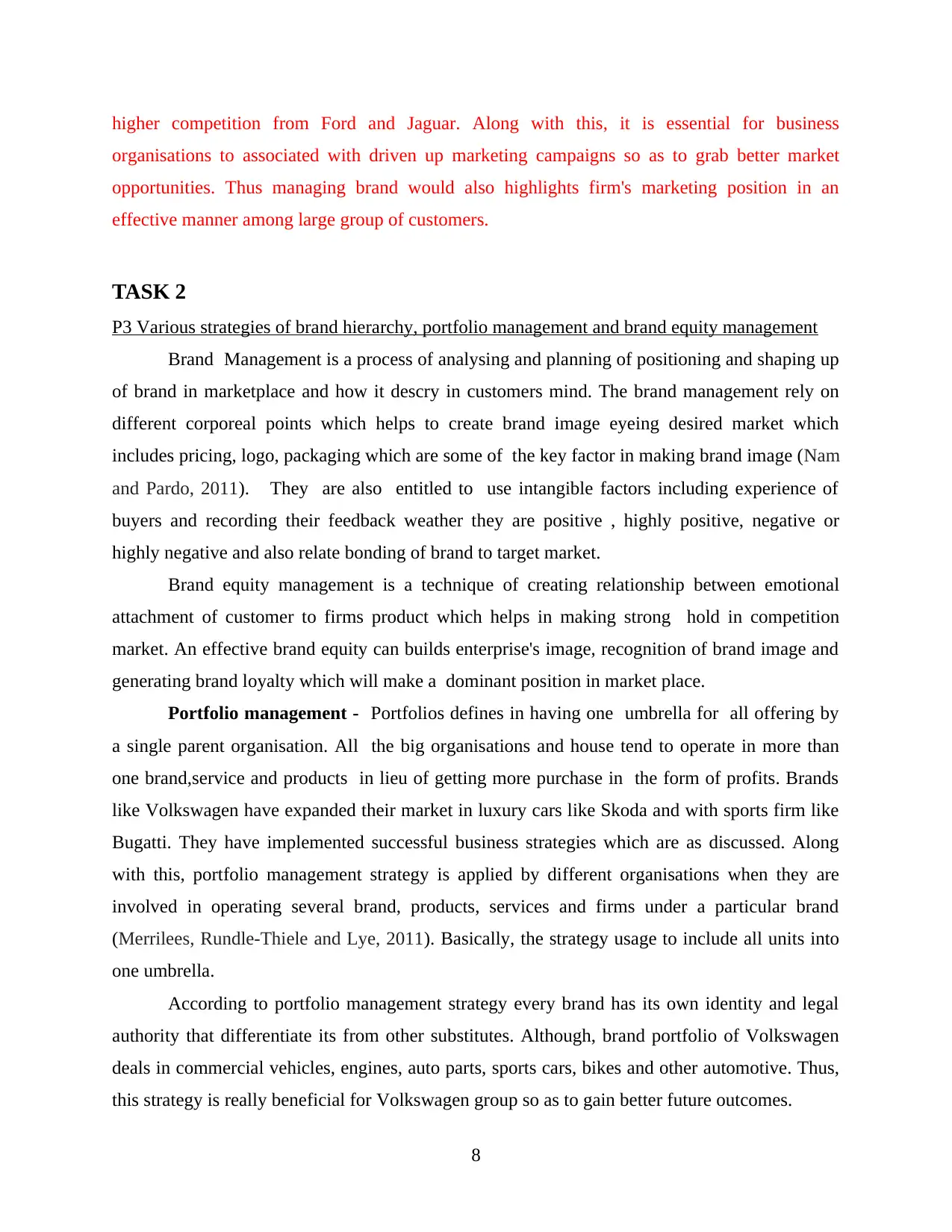
higher competition from Ford and Jaguar. Along with this, it is essential for business
organisations to associated with driven up marketing campaigns so as to grab better market
opportunities. Thus managing brand would also highlights firm's marketing position in an
effective manner among large group of customers.
TASK 2
P3 Various strategies of brand hierarchy, portfolio management and brand equity management
Brand Management is a process of analysing and planning of positioning and shaping up
of brand in marketplace and how it descry in customers mind. The brand management rely on
different corporeal points which helps to create brand image eyeing desired market which
includes pricing, logo, packaging which are some of the key factor in making brand image (Nam
and Pardo, 2011). They are also entitled to use intangible factors including experience of
buyers and recording their feedback weather they are positive , highly positive, negative or
highly negative and also relate bonding of brand to target market.
Brand equity management is a technique of creating relationship between emotional
attachment of customer to firms product which helps in making strong hold in competition
market. An effective brand equity can builds enterprise's image, recognition of brand image and
generating brand loyalty which will make a dominant position in market place.
Portfolio management - Portfolios defines in having one umbrella for all offering by
a single parent organisation. All the big organisations and house tend to operate in more than
one brand,service and products in lieu of getting more purchase in the form of profits. Brands
like Volkswagen have expanded their market in luxury cars like Skoda and with sports firm like
Bugatti. They have implemented successful business strategies which are as discussed. Along
with this, portfolio management strategy is applied by different organisations when they are
involved in operating several brand, products, services and firms under a particular brand
(Merrilees, Rundle-Thiele and Lye, 2011). Basically, the strategy usage to include all units into
one umbrella.
According to portfolio management strategy every brand has its own identity and legal
authority that differentiate its from other substitutes. Although, brand portfolio of Volkswagen
deals in commercial vehicles, engines, auto parts, sports cars, bikes and other automotive. Thus,
this strategy is really beneficial for Volkswagen group so as to gain better future outcomes.
8
organisations to associated with driven up marketing campaigns so as to grab better market
opportunities. Thus managing brand would also highlights firm's marketing position in an
effective manner among large group of customers.
TASK 2
P3 Various strategies of brand hierarchy, portfolio management and brand equity management
Brand Management is a process of analysing and planning of positioning and shaping up
of brand in marketplace and how it descry in customers mind. The brand management rely on
different corporeal points which helps to create brand image eyeing desired market which
includes pricing, logo, packaging which are some of the key factor in making brand image (Nam
and Pardo, 2011). They are also entitled to use intangible factors including experience of
buyers and recording their feedback weather they are positive , highly positive, negative or
highly negative and also relate bonding of brand to target market.
Brand equity management is a technique of creating relationship between emotional
attachment of customer to firms product which helps in making strong hold in competition
market. An effective brand equity can builds enterprise's image, recognition of brand image and
generating brand loyalty which will make a dominant position in market place.
Portfolio management - Portfolios defines in having one umbrella for all offering by
a single parent organisation. All the big organisations and house tend to operate in more than
one brand,service and products in lieu of getting more purchase in the form of profits. Brands
like Volkswagen have expanded their market in luxury cars like Skoda and with sports firm like
Bugatti. They have implemented successful business strategies which are as discussed. Along
with this, portfolio management strategy is applied by different organisations when they are
involved in operating several brand, products, services and firms under a particular brand
(Merrilees, Rundle-Thiele and Lye, 2011). Basically, the strategy usage to include all units into
one umbrella.
According to portfolio management strategy every brand has its own identity and legal
authority that differentiate its from other substitutes. Although, brand portfolio of Volkswagen
deals in commercial vehicles, engines, auto parts, sports cars, bikes and other automotive. Thus,
this strategy is really beneficial for Volkswagen group so as to gain better future outcomes.
8
Paraphrase This Document
Need a fresh take? Get an instant paraphrase of this document with our AI Paraphraser
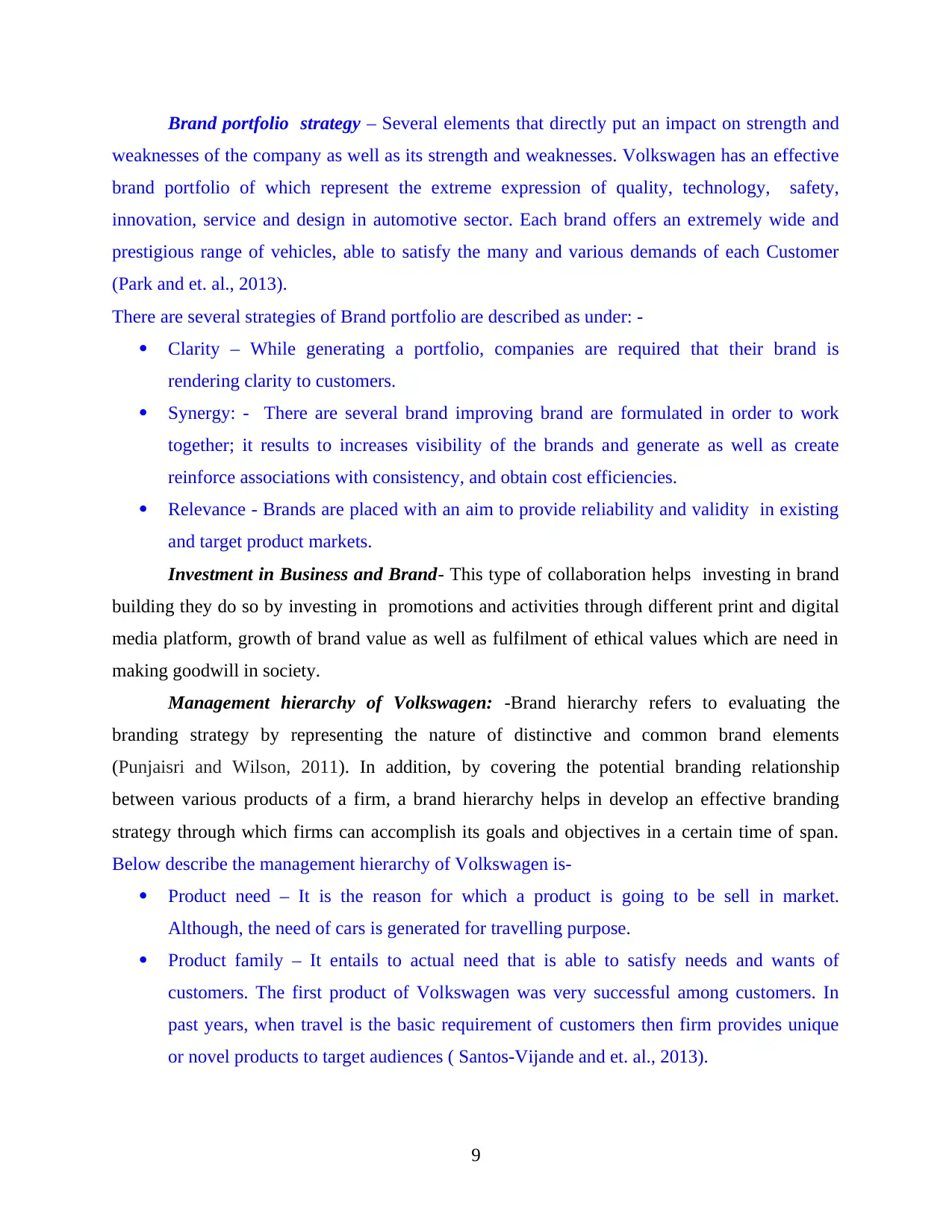
Brand portfolio strategy – Several elements that directly put an impact on strength and
weaknesses of the company as well as its strength and weaknesses. Volkswagen has an effective
brand portfolio of which represent the extreme expression of quality, technology, safety,
innovation, service and design in automotive sector. Each brand offers an extremely wide and
prestigious range of vehicles, able to satisfy the many and various demands of each Customer
(Park and et. al., 2013).
There are several strategies of Brand portfolio are described as under: -
Clarity – While generating a portfolio, companies are required that their brand is
rendering clarity to customers.
Synergy: - There are several brand improving brand are formulated in order to work
together; it results to increases visibility of the brands and generate as well as create
reinforce associations with consistency, and obtain cost efficiencies.
Relevance - Brands are placed with an aim to provide reliability and validity in existing
and target product markets.
Investment in Business and Brand- This type of collaboration helps investing in brand
building they do so by investing in promotions and activities through different print and digital
media platform, growth of brand value as well as fulfilment of ethical values which are need in
making goodwill in society.
Management hierarchy of Volkswagen: -Brand hierarchy refers to evaluating the
branding strategy by representing the nature of distinctive and common brand elements
(Punjaisri and Wilson, 2011). In addition, by covering the potential branding relationship
between various products of a firm, a brand hierarchy helps in develop an effective branding
strategy through which firms can accomplish its goals and objectives in a certain time of span.
Below describe the management hierarchy of Volkswagen is-
Product need – It is the reason for which a product is going to be sell in market.
Although, the need of cars is generated for travelling purpose.
Product family – It entails to actual need that is able to satisfy needs and wants of
customers. The first product of Volkswagen was very successful among customers. In
past years, when travel is the basic requirement of customers then firm provides unique
or novel products to target audiences ( Santos-Vijande and et. al., 2013).
9
weaknesses of the company as well as its strength and weaknesses. Volkswagen has an effective
brand portfolio of which represent the extreme expression of quality, technology, safety,
innovation, service and design in automotive sector. Each brand offers an extremely wide and
prestigious range of vehicles, able to satisfy the many and various demands of each Customer
(Park and et. al., 2013).
There are several strategies of Brand portfolio are described as under: -
Clarity – While generating a portfolio, companies are required that their brand is
rendering clarity to customers.
Synergy: - There are several brand improving brand are formulated in order to work
together; it results to increases visibility of the brands and generate as well as create
reinforce associations with consistency, and obtain cost efficiencies.
Relevance - Brands are placed with an aim to provide reliability and validity in existing
and target product markets.
Investment in Business and Brand- This type of collaboration helps investing in brand
building they do so by investing in promotions and activities through different print and digital
media platform, growth of brand value as well as fulfilment of ethical values which are need in
making goodwill in society.
Management hierarchy of Volkswagen: -Brand hierarchy refers to evaluating the
branding strategy by representing the nature of distinctive and common brand elements
(Punjaisri and Wilson, 2011). In addition, by covering the potential branding relationship
between various products of a firm, a brand hierarchy helps in develop an effective branding
strategy through which firms can accomplish its goals and objectives in a certain time of span.
Below describe the management hierarchy of Volkswagen is-
Product need – It is the reason for which a product is going to be sell in market.
Although, the need of cars is generated for travelling purpose.
Product family – It entails to actual need that is able to satisfy needs and wants of
customers. The first product of Volkswagen was very successful among customers. In
past years, when travel is the basic requirement of customers then firm provides unique
or novel products to target audiences ( Santos-Vijande and et. al., 2013).
9
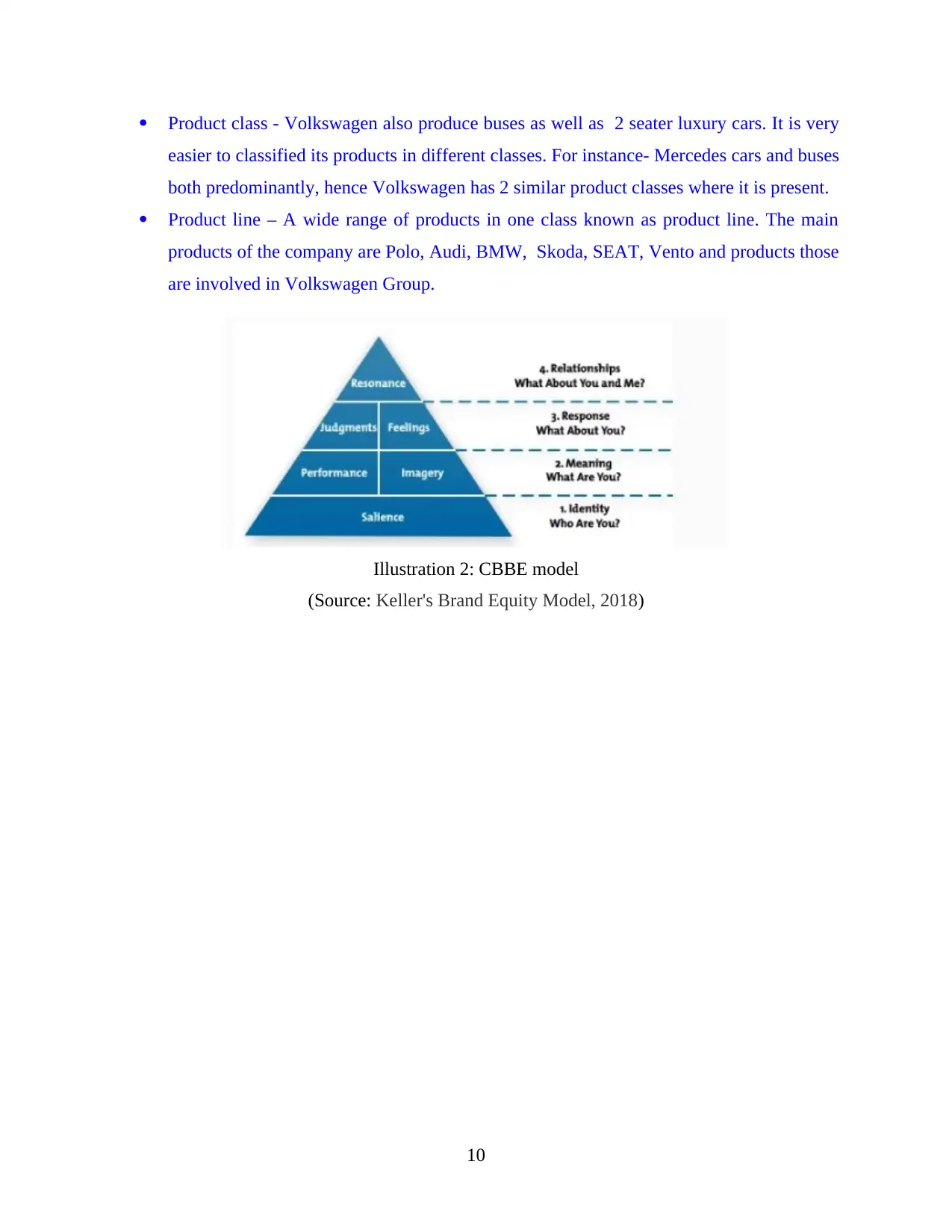
Product class - Volkswagen also produce buses as well as 2 seater luxury cars. It is very
easier to classified its products in different classes. For instance- Mercedes cars and buses
both predominantly, hence Volkswagen has 2 similar product classes where it is present.
Product line – A wide range of products in one class known as product line. The main
products of the company are Polo, Audi, BMW, Skoda, SEAT, Vento and products those
are involved in Volkswagen Group.
(Source: Keller's Brand Equity Model, 2018)
10
Illustration 2: CBBE model
easier to classified its products in different classes. For instance- Mercedes cars and buses
both predominantly, hence Volkswagen has 2 similar product classes where it is present.
Product line – A wide range of products in one class known as product line. The main
products of the company are Polo, Audi, BMW, Skoda, SEAT, Vento and products those
are involved in Volkswagen Group.
(Source: Keller's Brand Equity Model, 2018)
10
Illustration 2: CBBE model
⊘ This is a preview!⊘
Do you want full access?
Subscribe today to unlock all pages.

Trusted by 1+ million students worldwide
1 out of 21
Related Documents
Your All-in-One AI-Powered Toolkit for Academic Success.
+13062052269
info@desklib.com
Available 24*7 on WhatsApp / Email
![[object Object]](/_next/static/media/star-bottom.7253800d.svg)
Unlock your academic potential
Copyright © 2020–2025 A2Z Services. All Rights Reserved. Developed and managed by ZUCOL.





